Bohemian or Bohemians may refer to:
Contents
- Anything of or relating to Bohemia
Bohemian or Bohemians may refer to:
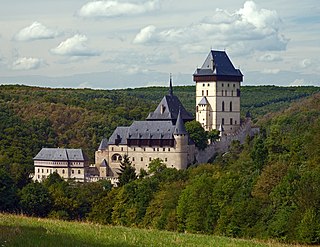
Bohemia is the westernmost and largest historical region of the Czech Republic. Bohemia can also refer to a wider area consisting of the historical Lands of the Bohemian Crown ruled by the Bohemian kings, including Moravia and Czech Silesia, in which case the smaller region is referred to as Bohemia proper as a means of distinction.

Moravia is a historical region in the east of the Czech Republic and one of three historical Czech lands, with Bohemia and Czech Silesia.

The Sudetenland is the historical German name for the northern, southern, and western areas of former Czechoslovakia which were inhabited primarily by Sudeten Germans. These German speakers had predominated in the border districts of Bohemia, Moravia, and Czech Silesia since the Middle Ages. Since the 9th century the Sudetenland had been an integral part of the Czech state both geographically and politically.
The history of the Czech lands – an area roughly corresponding to the present-day Czech Republic – starts approximately 800 years BCE. A simple chopper from that age was discovered at the Red Hill archeological site in Brno. Many different primitive cultures left their traces throughout the Stone Age, which lasted approximately until 2000 BCE. The most widely known culture present in the Czech lands during the pre-historical era is the Únětice Culture, leaving traces for about five centuries from the end of the Stone Age to the start of the Bronze Age. Celts – who came during the 5th century BCE – are the first people known by name. One of the Celtic tribes were the Boii (plural), who gave the Czech lands their first name Boiohaemum – Latin for the Land of Boii. Before the beginning of the Common Era the Celts were mostly pushed out by Germanic tribes. The most notable of those tribes were the Marcomanni and traces of their wars with the Roman Empire were left in south Moravia.

The Czechs, or the Czech people, are a West Slavic ethnic group and a nation native to the Czech Republic in Central Europe, who share a common ancestry, culture, history, and the Czech language.

The South Bohemian Region is an administrative unit (kraj) of the Czech Republic, located mostly in the southern part of its historical land of Bohemia, with a small part in southwestern Moravia. The western part of the South Bohemian Region is former Prácheňsko, a huge archaic region with distinctive features with its capital, Písek. In 2011, there were 624 municipalities in the region, whereof 54 had a status of a town.
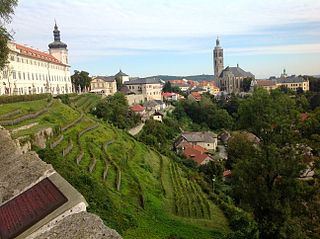
Kutná Hora is a town in the Central Bohemian Region of the Czech Republic. It has about 22,000 inhabitants. The centre of Kutná Hora, including the Sedlec Abbey and its ossuary, was designated a UNESCO World Heritage Site in 1995 because of its outstanding architecture and its influence on subsequent architectural developments in other Central European city centres. Since 1961, the town centre is also protected by law as an urban monument reservation, the fourth largest in the country.
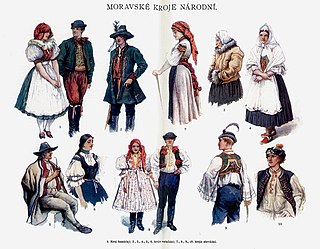
Moravians are a West Slavic ethnographic group from the Moravia region of the Czech Republic, who speak the Moravian dialects of Czech or Common Czech or a mixed form of both. Along with the Silesians of the Czech Republic, a part of the population to identify ethnically as Moravian has registered in Czech censuses since 1991. The figure has fluctuated and in the 2011 census, 6.01% of the Czech population declared Moravian as their ethnicity. Smaller pockets of people declaring Moravian ethnicity are also native to neighboring Slovakia.

Bohemianism is a social and cultural movement that has, at its core, a way of life away from society's conventional norms and expectations. The term originates from the French bohème and spread to the English-speaking world. It was used to describe mid-19th-century non-traditional lifestyles, especially of artists, writers, journalists, musicians, and actors in major European cities.

William-Adolphe Bouguereau was a French academic painter. In his realistic genre paintings, he used mythological themes, making modern interpretations of classical subjects, with an emphasis on the female human body. During his life, he enjoyed significant popularity in France and the United States, was given numerous official honors, and received top prices for his work. As the quintessential salon painter of his generation, he was reviled by the Impressionist avant-garde. By the early twentieth century, Bouguereau and his art fell out of favor with the public, due in part to changing tastes. In the 1980s, a revival of interest in figure painting led to a rediscovery of Bouguereau and his work. He finished 822 known paintings, but the whereabouts of many are still unknown.

The Duchy of Bohemia, also later referred to in English as the Czech Duchy, was a monarchy and a principality of the Holy Roman Empire in Central Europe during the Early and High Middle Ages. It was formed around 870 by Czechs as part of the Great Moravian realm. Bohemia separated from disintegrating Great Moravia after Duke Spytihněv swore fealty to the East Frankish king Arnulf in 895.
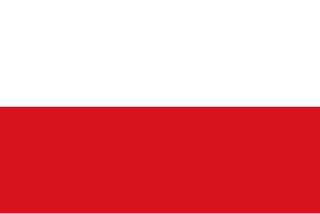
Although the Kingdom of Bohemia, both of the Lusatias, the Margraviate of Moravia, and Silesia were all under Habsburg rule, they followed different paths of development. Moravians and Silesians had accepted the hereditary right of the Austrian Habsburgs to rule and thus escaped the intense struggle between native estates and the Habsburg monarchy that was to characterize Bohemian history. In contrast, the Bohemian Kingdom had entrenched estates that were ready to defend what they considered their rights and liberties. The Habsburgs pursued a policy of centralization and conflict arose, which was further complicated by ethnic and religious issues.
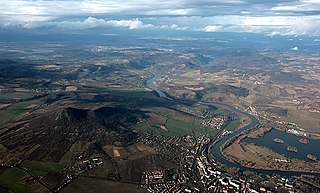
Ústí nad Labem Region or Ústecký Region is an administrative unit of the Czech Republic, located in the north-western part of the historical land of Bohemia, and named after the capital, Ústí nad Labem. It covers the majority of the former North Bohemia province and is part of the broader area of North Bohemia.

Šumperk is a town in the Olomouc Region of the Czech Republic. It has about 25,000 inhabitants. It is an industrial town, but it also contains valuable historical and architectural monuments. The historic town centre is well preserved and is protected by law as an urban monument zone.

The National Gallery Prague, formerly the National Gallery in Prague, is a state-owned art gallery in Prague, which manages the largest collection of art in the Czech Republic and presents masterpieces of Czech and international fine art in permanent and temporary exhibitions. The collections of the gallery are not housed in a single building, but are presented in a number of historic structures within the city of Prague, as well as other places. The largest of the gallery sites is the Trade Fair Palace, which houses the National Gallery's collection of modern art. Other important exhibition spaces are located in the Convent of St Agnes of Bohemia, the Kinský Palace, the Salm Palace, the Schwarzenberg Palace, the Sternberg Palace, and the Wallenstein Riding School. Founded in 1796, it is one of the world's oldest public art galleries and one of the largest museums in Central Europe.
Bohemia is a region consisting of the western two-thirds of the contemporary Czech Republic.
Bohemian Romani or Bohemian Romany was a dialect of Romani formerly spoken by the Romani people of Bohemia, the western part of today's Czech Republic. It became extinct after World War II, due to the genocide of most of its speakers in extermination camps by Nazi Germany.

The Czech Republic's official long and short names at the United Nations are Česká republika and Česko in Czech, and the Czech Republic and Czechia in English. All these names derive from the name of the Czechs, the West Slavic ethnolinguistic group native to the Czech Republic. Czechia, the official English short name specified by the Czech government, is used by many international organisations.
The history of Moravia, one of the Czech lands, is diverse and characterized by many periods of foreign governance.
After the Bath may refer to: